Whitehead & Hoag Company
Whitehead & Hoag was founded in 1892 in Newark, New Jersey, by Benjamin S. Whitehead (1858-1940) and Chester R. Hoag (1860-1935) when the two teamed up to combine their expertise and formalize their friendship.
Benjamin Whitehead had studied Printing at the Cooper Union Institute in New York City and first distinguished himself as a printer when his products were exhibited at the 1876 Centennial Exposition in Philadelphia. He was very enterprising, traveled a lot and collected ideas for novelties that he might later prodce in his shop.
Chester Hoag had no formal education beyond grammar school but was a voracious reader and self-educator. Hoag first met Whitehead when he sold him paper and twine for his printing business. At the time, Whitehead was busy printing programs and badges for local picnics and parties. The business developed in conjunction with their friendship.
In 1892 the two friends decided to team up and formally incorporated under the name Whitehead & Hoag Company. Over time they developed expertise in manufacturing buttons and acquired three major patents that allowed them to grow the company into the dominant player in this lucrative field. Buttons were in high demand as they were a very cost-effective way of advertising, both in business and in politics, and Whitehead & Hoag serviced that demand very well.
During the Second World War Whitehead & Hoag employed over 400 workers but it could not successfully grow from a mid-sized family-owned company to a large corporation. In 1953 the last founders' family member with an active interest in the company died and the firm started deteriorating. One or two profitable years would be followed by several years of financial losses. In 1959, a long-time competitor, Bastian Bros. of Rochester, N.Y., bought the business.
It appears that more than a little vengefulness were at work in winding down operations. Rather than merging Whitehead & Hoag into Bastian's business, the new owner ordered the factory to be sold and all dies and records destroyed. Thus the carefully archived records and dies of many beautiful medals were lost.
Bastian kept the tradename Whitehead & Hoag alive till 1965 but then stopped using it completely. While the real end had come years earlier, 1965 marks the official end of Whitehead & Hoag, a once proud firm that had produced quality medals for many years.
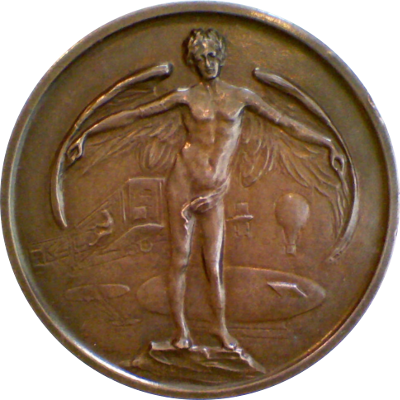
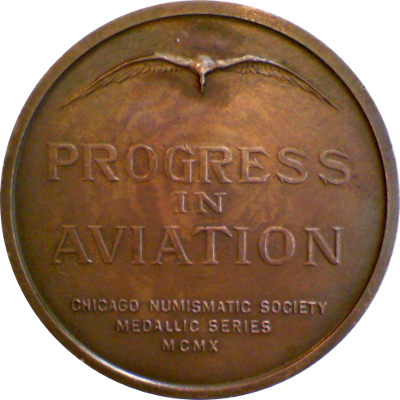
This medal's obverse bears a male figure with wings affixed to his outstretched arms, four different methods of manned flight in background: a hot air balloon, a dirigible, and two early-model airplanes.
The reverse bears bird in flight. Across center, PROGRESS / IN / AVIATION / CHICAGO NUMISMATIC SOCIETY / MEDALLIC SERIES / MCMX
The second art medal issued by the Chicago Numismatic Society (the precursor to the Chicago Coin Club) was dedicated to Aviation. In the early 20th century Chicago was one of the hotbeds of aviation engineering. Thus it came as no big surprise that it was decided to pick Progress in Aviation as the theme for an art medal. Carl Schrieber won the competition for the design of this medal.
The circular medal measures 51mm in diameter and was struck in bronze by Whitehead & Hoag of Newark, New Jersey. The reported mintage in bronze is 200 pieces. The silver pieces were struck later, possibly by the U.S. Mint. No mintage is reported.
References: Malpas 186
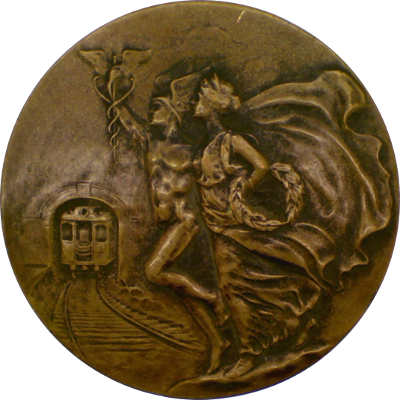
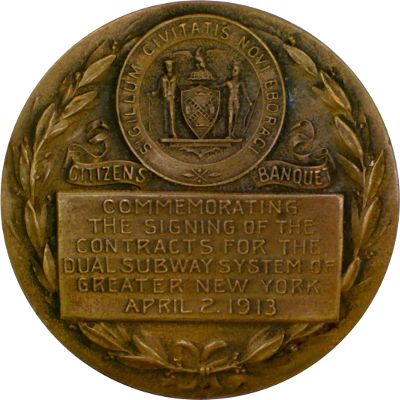
The obverse bears the seal of the city of New York in a wreath. Inscription reading CITIZENS - BANQUET / COMMEMORATING / THE SIGNING OF THE / CONTRACTS FOR THE / DUAL SUBWAY SYSTEM OF / GREATER NEW YORK / APRIL 2, 1913
The reverse bears Hermes, god of travel, conducting a female figure, representing the City, to an approaching subway train.
The banquet on April 2, 1913 capped a time of contentious negotiations, dealings and inter-burrough fighting over the layout and cost of new subway lines and the awarding of the operational contracts. At the banquet, city officials and taxpayers in favor if the chosen plans celebrated the signing of operations contracts for the subway line extensions.
As a keepsake, the guests of honor were handed this medal in gold, whereas regular diners were given a bronze version. While speakers widely praised the artistry of the medal, borough president McAneny caused a good deal of laughter when he speculated that the two figures on the medal were really Brooklynites who had lost their clothing when trying to get on one of the present subway trains during rush hour.
I have intentionally switched the obverse and the reverse images for this medal to show the beautiful, artistic side first. I don't usually do that but I agree with the banquet guests: this is a very artistic medal. I wish I knew the artist who created it. Please contact me if you have any knowledge you can share.
The circular medal measures 51mm in diameter and was struck in gold and bronze by the Whitehead & Hoag Company of Newark. The mintage is not reported.
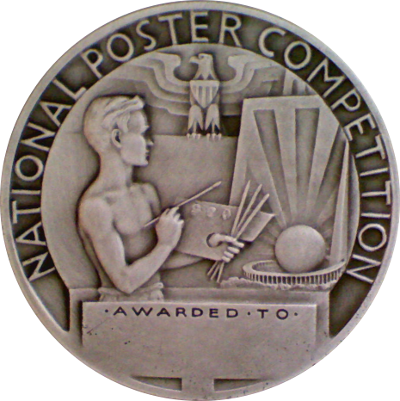
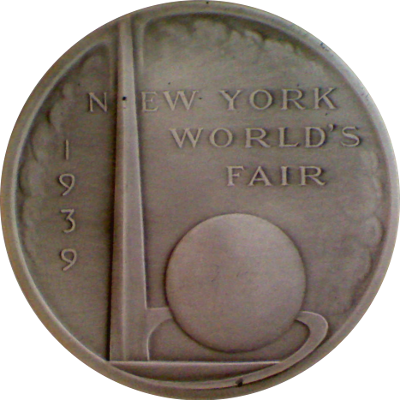
The medal's obverse bears boy painting poster with World's Fair motif in front of eagle. Around, NATIONAL POSTER COMPETITION.
The medal's reverse bears the New York World's Fair motif of trylon and perisphere. To left of trylon, 1939; across, N - EW YORK / WORLD'S / FAIR.
The National Poster Competition was officially announced on March 30, 1937 and was open to students throughout the United States. Participants could submit original poster designs for the New York World's Fair of 1939/40.
The medal was struck in bronze and silver, with the silver pieces being much rarer than those struck in bronze.
This medal measures 51mm (2in) in diameter and was struck by the Whitehead & Hoag Company of Newark, New Jersey.